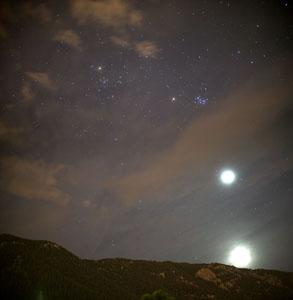
The evening sky in March 2004, The bright moon is on the horizon, with overexposed Venuus above and bright redddiish Mars near the Pleiades.
by Paul Doherty
Here are some highlights from the public programs at the Exploratorium developed to accompany the missions of the Mars Exploration Rovers in January 2004.
The Exploratorium is a hands-on Museum of Science, Art, and Human Perception founded by Frank Oppenheimer in 1969. It has exhibits, education programs, and a large presence on the web. We are four time winners of the Webby Award as best science education site.
The Exploratorium presents public programs that accompany every NASA planetary mission to help the public understand the science behind the Mission. As the senior scientist at the Exploratorium and a planetary physicist I develop and present many of these programs.
This is a lecture for the public featuring images and demonstrations.
Music Holst
Mars The Planet

The evening sky in March 2004, The bright moon is on the horizon,
with overexposed Venuus above and bright redddiish Mars near the
Pleiades.
Bright Planet
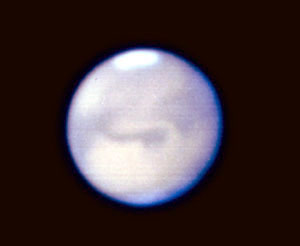
A good earth surface telescope view of Mars.
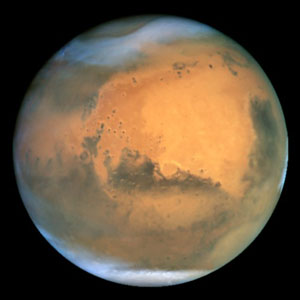
The Hubble Telescope View of Mars
DVD Getting to Mars DVD
View from the Hubble telescope during a Martian dust storm.
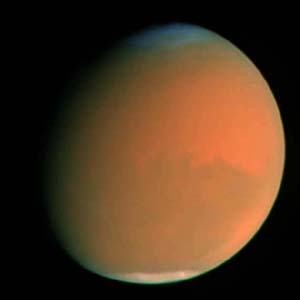
Mars sometimes is shrouded by dust storms that hide the surface from
view.
But when the sky clears we get amazing views of the surface.

The mesas of Mars. Photo by ESA
The View from the surface Mars.
We have landed spacecraft on Mars and they have sent back images.
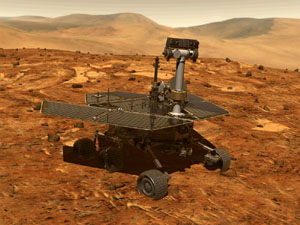
An artist's illustration of the rover on Mars.
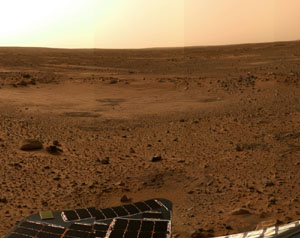
The view from the spirit rover.
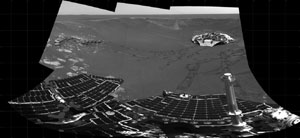
Mars Opportunity scored a hole-in-one and landed in a
crater.
The Mars Rovers had geologist's hand-lenses to get a close up of the surface. This picture is the size of 3 postage stamps.
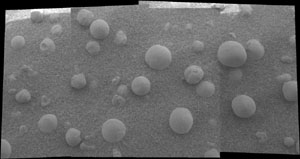
The spheres known as "blueberries" on Mars. They are made of
hematite.
A Human View of Mars
If you were able to stand on Mars, suitably protected by a Mars suit, what would you see?
Here are some of my ideas of what you might see
illustrated by images from mars landers.
I've included my own images taken on earth for comparison.
The Color of Mars The Color of Blood
Look at Mars in the sky, it is slightly red in color. To the ancients this reminded them of the color of blood, and so Mars was named for the god of war.

An image from Mars Pathfinder adjusted to give an accurate
color portrayal of Mars surface and sky. Click to enlarge.
Mars Pathfinder. image NASA/NSSDC
The dust of mars is red, well actually it is butterscotch tan, because the dust of Mars is made from weathered "limonite" a brown iron oxide. Blood also gets its red color from iron in hemoglobin.
(limonite is not actually a mineral but a mixture of hydrated iron oxide minerals such as goethite FeO(OH). Mars surface dust may also include red hematite, Fe2O3, one of the main ingredients of rust on Earth. The dust also contains 1% magnetite, Fe3O4, a magnetic mineral.
On earth iron containing minerals weather to a reddish color as well.
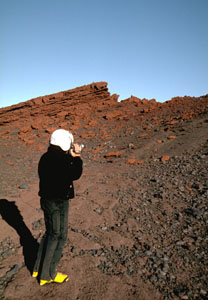
An earth image from Antarctica blue sky, red weathered
volcanic rock near Mt. Morning. Image by Paul Doherty
Activity: Drag a magnet through dirt or sand, it will collect iron particles and iron oxide particles and some yellowish/brown limonite.
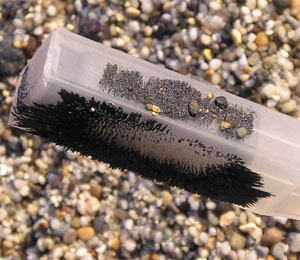
A magnet drawn through California beach sand collects black
magnetite and tan limonite.
Half the light at the surface of Mars comes from direct sunlight, half is scattered by the dust-filled sky, thus objects on Mars appear reddish in color.
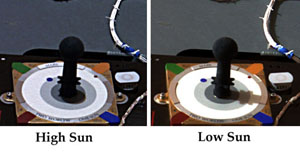
The shadow of the gnomon on this sundial is filled in by light
scattered from the sky. Photographers would say the light is the
shadow is one f-stop darker than the sunlit portion which means that
half as much light fills the shadow.
Activity, find a pair of "Blue Blocker" sunglasses, these sunglasses look yellow-brown. Look at the world through these sunglasses to get an idea of what things would look like on Mars.
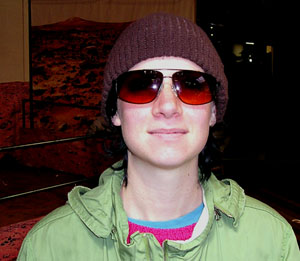
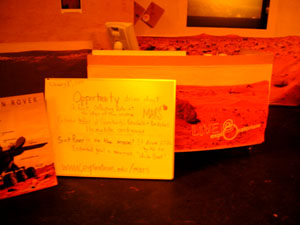
Left, Alissa shows off Blue Blocker Sunglasses. Right a view
of the whiteboard in our webcast theater through these
sunglasses.
Activity: eat butterscotch notice the color and think of Mars.
Without the dust the sky of Mars would be black as is the sky on earth at 115,000 feet the elevation at which the earth's atmosphere has the same density as the atmosphere at the surface of Mars.
Activity: The next time you are making a long distance flight in a 747 and the captain announces a cruising altitude near 50,000 feet look out the window to get an idea of what the sky would look like on Mars at the surface.
The sky of earth viewed from 50,000 feet elevation. The sky is mostly black.
The red dust is blown into the sky on mars by winds, it settles out slowly and the finest dust remains suspended for very long times since it is never washed out of the air by rain.
The finest particles of dust on Mars are smaller than a wavelength of light, smaller than 0.5 micrometers. Some larger particles are tens of micrometers, much larger than a wavelength of red light.
The particles absorb blue light. They scatter all wavelengths of light. The sky is colored reddish by the dust(all colors are scattered minus blue light which is absorbed.)
The sky of Mars looks like the sky of Los Angeles when it is colored reddish by photochemical smog, which also absorbs blue light. Exhaust gasses from automobiles include nitrogen compounds which are converted into smog by the ultraviolet light in sunlight. After a rainstorm in Los Angeles the sky is cleared of smog and the blue sky of earth returns again, briefly.
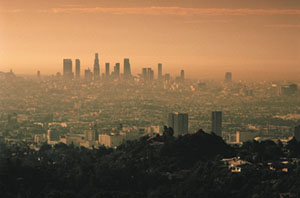
Smog over Los Angeles. The brownish color is due to
photochemical smog, mostly nitrogen oxides. The color here is due to
molecular absorption of blue light, unlike Mars where particles
absorb and scatter light. Image EPA.
Sunrise Sunset
Sunrises and sunsets seen through the atmosphere of Mars appear greenish-blue or cyan.

Mars sunset panorama with accurate colors. Note bluish region
around the sun. Image NASA/NSSDC.
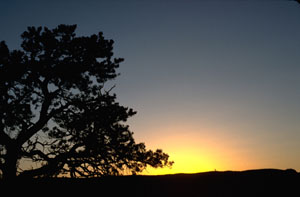
Earth Sunset, note yellowish sky near the sunset amid blue sky. Image
Paul Doherty
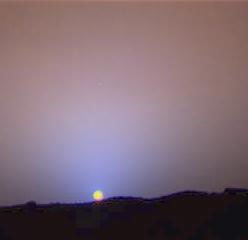
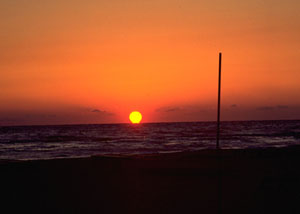
Mars sunset left from Pathfinder bluish sky around the sun against a
salmon colored sky, Earth sunset on right reddish sky around the sun
in a blue sky. Image left NASA/NSSDC, Image right Paul Doherty.
The sizes of the dust particles on Mars produce Mie scattering. This scatters blue light more strongly along the line from the sun to the dust particle. Thus at sunset when the sunlight passes through the largest amount of dust, the sky near the sun becomes bluish with the "forward" scattered blue light.

Sunset from the opportunity rover
Hear
Hearing on Mars, the thin air does carry sound, just not as well as the thick air of earth.
In fact with the air density 100 times lower on Mars the sound intensity carried to your ear is 100 times less. The ear is a logarithmic detector however so the sound level decreases by 20 dB.
Demo: This is the same decrease in sound produced by covering your ears with your hands. Cover your ears to hear what it sounds like on Mars.
Demo, put a boombox and a tape recorder into a vacuum chamber then record the sound at Earth and Mars pressures. The recorded sound is much quieter under Martian atmospheric conditions.
Smell
Smelling, Mars would smell like carbon dioxide gas, CO2. Recently the Mars rovers have identified sulfur compounds in the atmosphere of mars that may add a tinge of rotten egg odor. Imagine rotten egg flavored soda.
Demo: put some dry ice into a fish tank, waft the CO2 from the dry ice toward your nose to smell Mars. Or open a bottle of soda water and immediately smell the neck of the bottle to smell outgassed CO2.
Or put dry ice into an open 2 Liter bottle and squirt CO2 toward your nose and tongue.
Taste
Demo: Taste Mars, put your tongue into the tank of CO2 or put dry ice into a 2-liter bottle and squirt some CO2 onto your tongue. Tangy!
Feel
Feel Mars,
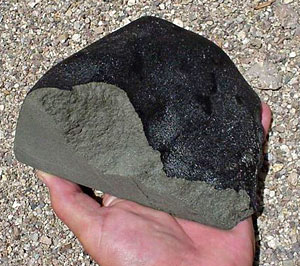
A piece of the Zagami meteorite. A piece of Mars.

We mounted the mars grains onto holders so that visitors could feel them.
It is very cold on Mars, the temperature in the winter plunges to 140 K or -130 °C, in the summer at the equator it can reach +25 °C.
Rule to live by, Don't put your tongue onto metal pipes on Mars.
Mars is also very dry, like the air in the Antarctic Dry Valleys or the Atacama Desert on Earth.
Weight
Mars gravity is about 1/3 of earths gravity (actually 0.37 g)
You would have the same mass. The astronauts on the moon adapted very quickly to this combination, but they did stumble and almost fall a few times.
Demo use the Mars swingset and a bathroom scale to show weight on Mars.
Ultraviolet
UV would be over 100 times as intense at the surface of Mars as it is on the highest driest equatorial deserts of earth since there is no ozone layer.
I would sunburn in 15 seconds of exposure!
Sunblock
Climbers need factor 100 sunblock on Mars to replace the shielding of earth's ozone layer. Mars has no ultraviolet shielding. And, Mars is 1.5 times further from the sun so the UV dose is reduced buy the inverse square of this distance, that is by a half. The earth's ozone layer is factor 256 sunblock. The combination of these two affects leads to the need for factor 100 sunblock. Of course, on earth I need factor 50 sunblock at high desert locations near the equator on earth, in addition to the ozone layer, so on Mars I'd need factor 5000 sunblock.
Magnetic sense
Animals with a magnetic sense would not sense Mars since there is no planetary magnetic field.
Playing Around on Mars
Camping on Mars
Sitting around the old magnesium fire.
Paul Doherty and Eric Muller
Camping
First Things first
Oxygen
If you try to breathe Mars air you would pass out in 15 seconds due to lack of oxygen. So, campers would need to carry their own oxygen, O2. The movie "Total Recall" starring now California governor Arnold Schwartzeneger gives you an idea of what would happen to you if you tried to breathe Mars atmosphere.
Mars' atmosphere is approximately 95% CO2 and 3% N2 and 2% Ar.
Demo. Put dry ice into a fish tank and let the tank fill with carbon dioxide. Gently waft some of the CO2 toward your nose, smell it to find out what Mars smells like. Stick your tongue into the tank and taste the CO2. Wow! be prepared for a sharp taste like that from a carbonated beverage.(We'll use the tank of CO2 again in other experiments below so keep it around.)
However, when water is added to the surface of Mars it releases oxygen, so all you have to do is pee on the surface to generate O2. Viking landers discovered that the surface contained iron superoxides, when Viking added water to the soil oxygen was released. Scientists, Dr. Chris McKay from NASA AMES research laboratories, recently found the same kind of oxidizing soil in the Atacama desert of Chile.
Demo, Get a platinum coated plastic contact lens cleaner. Drop it into a test tube of hydrogen peroxide (20%) and oxygen will bubble out. H2O2 goes to H2O + O. This models the production of oxygen by mars soil when it is wetted.
If there is water on Mars then solar power can be used to split the water, H2O, into hydrogen and oxygen.
Water
The MER spacecraft have found signs of past water on Mars. Spacecraft show that the soil near the surface on Mars near the equator is only 3% water. The polar caps do contain a lot of water ice. The Mars Express spacecraft in orbit carries radar which is looking for water ice beneath the surface of Mars. So you will be able to fill your water bottle when you get to Mars, although it might require some work.
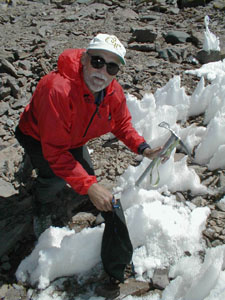
In the mountains on earth and on the surface of mars water
might always be in the solid state. Paul Morgan gathering water for
dinner at 18,000 feet, 5,500 m, on the first ascent of Sierra Nevada
de Lagunas Bravas in Chile.
Fire
Most things won't burn on mars, after all, the main ingredient in the atmosphere, carbon dioxide or CO2, is used in fire extinguishers on Earth.
Demo, make a fish tank full of CO2 gas. Drop dry ice into warm water in a pitcher to create a cloud, pour the cloud into the tank and notice how it floats as a stratus cloud layer above the CO2 in the tank. Carbon dioxide is heavier than air and so it sinks into the tank and stays there. Lower a candle into the tank and then a lighter and watch them extinguish. Notice in particular how the flame from the lighter leaves the top of the CO2 and enters the air. Try a camping stove it also goes out as it is lowered into the tank.
However, metals will burn in a CO2 atmosphere.
Demo: Eric lowers a burning magnesium ribbon into the carbon dioxide atmosphere in the tank, it continues to burn. Magnesium can tear apart the carbon dioxide, burn with the oxygen to make magnesium oxide, and leave the carbon behind The magnesium ribbon becomes white, magnesium oxide, with black spots from the carbon.
Demo: Place magnesium powder into a hollow carved into two blocks of dry ice. Insert a fuse of magnesium ribbon into the powder and light the fuse. Put one block on top of the other to seal the magnesium from air. The magnesium burns inside the CO2 producing a beautiful glow. Open the blocks when the fire is out and notice the white magnesium oxide and the black carbon left behind.
Cooking
Cooking is difficult, the pressure is so low on Mars that water boils at 0°C. You would definitely need to use a pressure cooker.
Air Pressure on Mars, is less than 1/100 of the air pressure on earth.
Demo, A steel rod 1 inch square, 2.5 cm square, and 1.3 m long will exert the same pressure as the earth's atmosphere. To feel Martian pressure cut the length of the rod to 1/100 of this length or 1.3 cm. A Venus atmosphere rod would be 120 high, and weigh 750 Kg, nearly a ton.
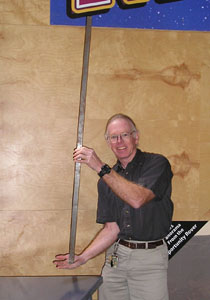

Left, a steel Bar 1.32 m long and 2.5 cm square exerts the same
pressure as the earth's atmosphere, it masses 6.5 kg and weighs 14.7
pounds. (it exerts 101 kpascals.) A steel Mars atmosphere bars is
only 1.32 cm high.
The unit of atmospheric pressure on earth is the Bar, on mars it is of course the mars bar. Don't worry if you can't cook on Mars you can always eat... mars bars!
Demo, Show the candy bar.
At Mars pressure, water boils at 0 °C, you can show this using a vacuum chamber or a syringe.
So to cook on Mars you'll need a pressure cooker. Spaghetti cooked in a carbon dioxide Martian atmosphere pressure cooker would be spaghetti carbonara.
Altitude Illness
On earth, to deal with illness caused by low atmospheric pressure, climbers get into a Gamow Bag which can be pumped up to high pressure. It's rather claustrophobic, and you do look like a hot dog, but it can save your life. Perhaps the first Mars team will live in a pressurized fabric dwelling.
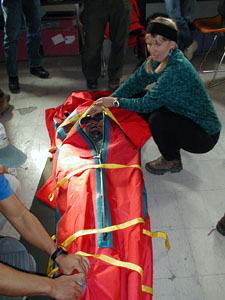
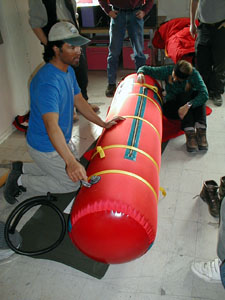
Left, a person inside an open Gamow bag, right, an inflated
Gamow bag. Click images to enlarge.
Pressure and Oxygen
Climbers would need to wear a pressure suit, and carry oxygen. The atmospheric pressure on Mars averages 6 pascals, 6 thousandths the atmospheric pressure of earth, equal to the atmospheric pressure on earth at 35,000 m above sea level. People cannot breathe without additional oxygen above 10,000 m. Even breathing pure oxygen is not enough above 15,000 m. For flights above 12,000 m pilots "pressure breathe, that is, pure oxygen is forced into their lungs under pressure, this pressure would blow them apart unless they were squeezed inward by wearing a pressure suit. Pilots need a pressure suit above 20,000 m for an additional reason, their blood would boil at body temperature if they were exposed to the ambient air pressures at these altitudes. On all of Mars the pressure is so low human blood would boil unless the person were protected by a pressure suit.
Gravity
Your backpack would weigh less under the 1/3 g
gravity of Mars.
But you'll need to carry more stuff.
Temperature
The temperature will never get below -210 °F, -130 °C,since at that point the Martian air freezes solid and releases energy as it does so. But even a warm night gets down to -100 °F, as cold as the coldest winter nights in Antarctica. So you'll need a thick sleeping bag.
Demo show a -40 degree sleeping bag(-40 is the same temperature in Fahrenheit or Celsius.) Then a -60 °C sleeping bag (made by putting an overbag over the -40 bag.) Notice how thick the bag is.
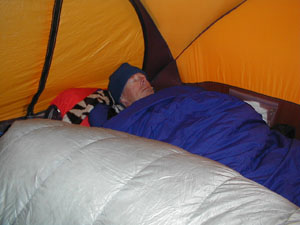
Packed in a tent like sardines. -40°F outside, Sierra Nevada,
Chile.
You'll need a wind breaker since the winds are fast, but the air is thin, so it will exert less force.
However complete thermal protection from the cold will be required, here is a picture of Noel Wanner on the summit of Mt. Erebus in Antarctica, at the time of this photo it was -20 C with 30 kph winds. When Noel removed his face mask for a minute his nose turned white with incipient frostbite.
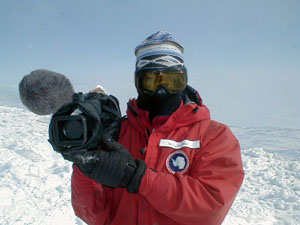
Noel Wanner dressed for the summit of a cold Antarctic
mountain. No flesh is showing. He lowered his hood for the
photograph.
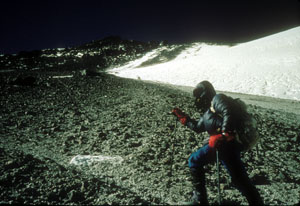
Paul Doherty climbing Ojos de Salado, -30 C and 50 kph winds.
Working hard going uphill at 6000 m elevation, and still cold.
Navigation
A compass will not work on Mars. Neither will GPS.
There is a South Pole Star on Mars, Kappa Velorum, magnitude 2.46 just 2 degrees from the actual pole. Polaris, the north pole star on earth is brighter, and closer to the pole, less than a degree from the north celestial pole. There is no north pole star on Mars just as there is no south pole star on earth.
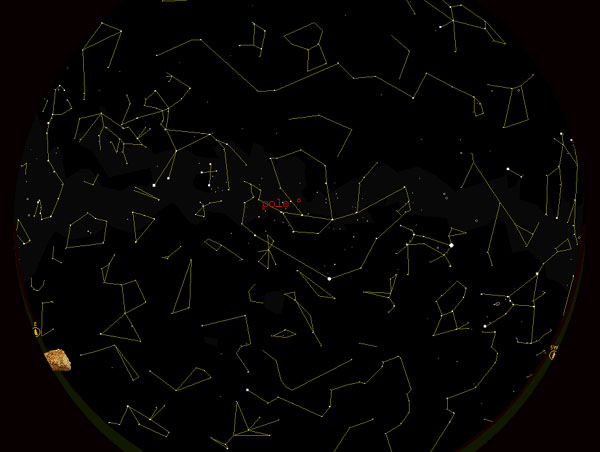
The south pole star on Mars is Kappa Velorum, just to the left
of the pole in this image. Click to enlarge. How
things move in the thin air and lower gravity of Mars.
Playing on Mars
Notes:
Baseball
The acceleration of gravity is 1/3 what it is on earth. So a ball hit into the air stays in the air for three times longer. It goes 3 times higher. You can hit a ball more than 3 times further.
I say "more than" three times because the air drag is so much less on mars, (even without lift from a spinning ball.)
You can hit 300 meter home runs on Mars. So fields
will have to be 3 times longer and 3 times wider.
Fielders will have to cover 9 times the area. Luckily they have a
longer time to do it. Unluckily their top speed on Mars is
reduced.
They may even have to use the kangaroo hop that astronauts on the moon found to be a good way to cover distance. DVD of astronaut motion on the moon.
Demo
Make an Atwoods machine with a baseball counterbalanced over two pulleys with a half baseball. The whole baseball will fall at 1/3 gravity. Drop it and toss it to see how it might move on Mars.

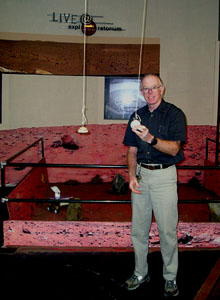
A Martian baseball counterbalanced by a half baseball on a pulley
system falls at 1/3 g.
Pitchers cannot throw curve balls on Mars. Usually the threads on the spinning ball throw air to the side and make the ball curve by what is known as the Magnus effect. The air on mars is 100 times less dense than the air on earth so the spinning ball gets little thrust from the little air it deflects. It will deflect 100 times less distance on Mars.
Falling
It's not a sport, but I do it in many sports!
To drop to the ground from a given height only takes 1.7 times as long on Mars (the square root of 3 times as long.)
Doing the math:
Distance d= 1/2 at^2 where a is acceleration and t is time. Solve for t, on earth t = (2/g)^0.5 on Mars t = (2/0.33g)^0.5, o on mars the time to fall a given distance is the time it takes to fall the same distance on earth divided by the square root of 3, which is about 1.7.
Paper Airplanes
Paper planes would not fly well on Mars, there is 100 times less lift in the thin air of Mars but also 1/3 of the gravity.
Demo You can model the flight of paper planes on Mars here on earth by folding paper planes from 30 sheets of paper, giving them the same lift as a normal paper plane but 30 times the mass.
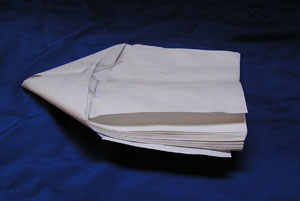
Basketball and Volleyball, You can jump 3 times higher on Mars.
Demo
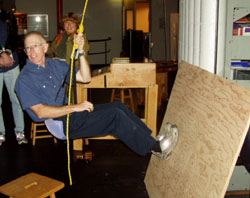
Use the Mars swingset,
Put a regular basketball hoop and show that on Mars even a fifty year old white guy can stuff the ball.
Skateboarding, you get 3 time the hang time on Mars, you can Ollie 3 times higher, but you'll need to practice the timing. You can Ollie 3 times further.
Anyone who can do a 720 degree turn on earth can do a 2160 on Mars.
Golf
Mars is one big sand trap. At least there are no water hazards, but there are no greens either.
Hooks and slices will be 100 times smaller per second of flight time for the ball due to the 100 times thinner atmosphere. The drives will be in the air 3 times longer and go 3 times further. But your slice distance will still be less. 1/100 * 3^2 = 1/10 as much. Still not enough to help me. And professional players use hooks and slices to navigate some fairways.
Martian Snowflakes
Ice crystals on Mars
Clarence Bennett and I are the discoverers of the shape of dry ice snowflakes grown under Martian conditions.
Read my story about the discovery of Martian Snowflakes.
Martian Ice
There is ice on Mars. The planet has polar ice caps which can be seen in telescopes from earth. The ice in the polar caps of mars is both water ice and also carbon dioxide ice.
There is probably underground ice as well. Images of mars show pedestal craters which are craters surrounded by what look like mud flows. These craters are thought to be created when a meteorite hits a region containing substantial subsurface ice. there are also polygonal patterns on the surface of mars that look like polygons found on earth in regions with permafrost.
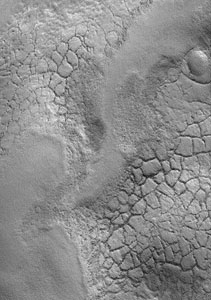
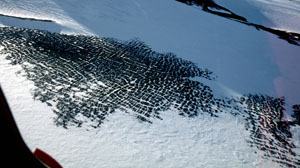
Left, Rock polygons on Mars. Right, Polygonal fractures in
Antarctica. Click either picture to enlarge. Left image Malin Space
Science Systems, JPL, NASA.
The Mars Express spacecraft which went into orbit of Mars in 2003 contains ground penetrating radar that will look beneath the surface of Mars to find underground ice.
Sometimes Martian ices appear on the surface of Mars away from the polar caps.
The Viking2 lander awoke one morning to find that it was surrounded by a white landscape. The ice surrounding it had formed when the overnight temperature dropped to 140 K, the temperature of carbon dioxide ice crystallization, but it didn't melt away at higher temperatures. Scientists assumed that the white frost contained water ice that formed on carbon dioxide ice seed crystals.
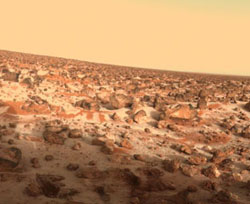
Heavy white frost on the ground around the Viking lander.
Click to enlarge.
Martian Clouds
There are clouds on Mars. One region of clouds on Mars that is visible from earth astronomers was named "Nix Olympica", the snows of Olympus. When spacecraft revealed that the clouds formed over a giant volcano it was named Olympus Mons.
We can also see Martian clouds forming waves over the raised rims of craters.
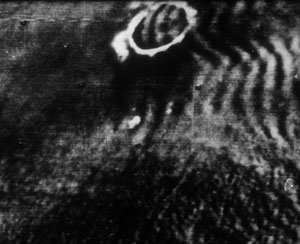
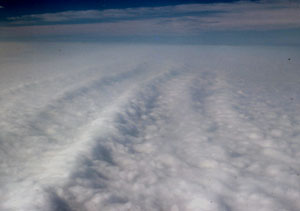
Left. Wave clouds form over a crater on Mars, the crater rim
is white with ice deposits. Right Wave clouds also form on earth.
Click either image to enlarge.
We also saw clouds at dawn from the pathfinder lander. These are probably high thin ice crystal clouds.
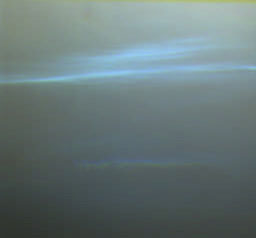
Bluish ice crystal clouds at dawn viewed from the pathfinder
lander.
On earth clouds are made of water drops and water ice crystals. On Mars clouds are made of water ice and carbon dioxide ice (dry ice.)
Clouds can also be seen over the dusty atmosphere at the limb of Mars.
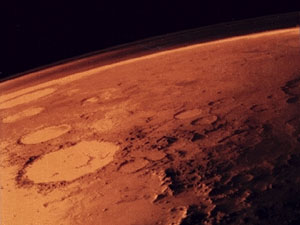
Clouds over the dusty atmosphere at the limb of Mars.
Thinking about the ice crystal clouds of Mars I wondered what the size of the halos around the sun would be? To find out I needed to know the shape of Martian snowflakes made by water ice and carbon dioxide ice. I found that many people had done research on the shape of water ice crystals, but I couldn't find information on carbon dioxide ice crystal shapes formed under Martian conditions. So I decided to make a Mars chamber and make my own Martian dry ice snowstorm within it. Then I would find out for myself what the shape of a Martian carbon dioxide ice crystal might be. I enlisted the aid of Clarence Bennett. (Clarence is a member of PIRA, physics instructional resource agents.)
Snowflakes on Earth
Below is a photograph of an ice crystal growing on a spiderweb on earth.

This is an ice crystal growing on a spider thread. It is six
armed, and is how we envision snowflakes on earth.
"Snowflake" Bentley photographed thousands of snowflakes in Vermont. His photos show that snowflakes can take on many different shapes. Here is one page from his book which is still in-print and available.
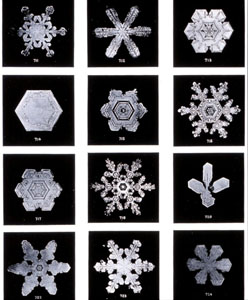
Photographs of snowflakes by Bentley. Click to enlarge.
(Note Bentley never copyrighted his photographs so the are avaiable for noncommercial use. Many of his snowflake images will be found on the NOAA photograph website.)
Notice in particular the flat plate snowflake without arms.
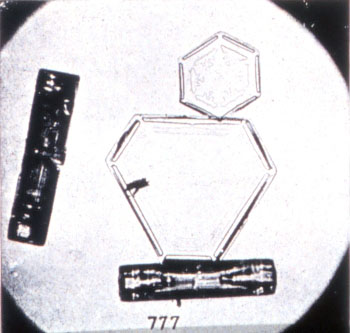
Flat plate and six-sided prism snowflakes photographed by
Bentley.
He also photographed pencil shaped snowflakes.
(Unsharpened pencils without erasers are 6 sided prisms just like
some snowflakes.)
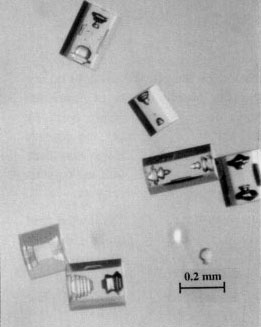
Images of hexagonal prism snowflakes (with internal air bubbles.)
Photo from a book by Walter Tape.
I have a book by Walter Tape in which he shows images of snowflakes he collected in Antarctica at the same time he was observing ice crystal halos around the sun.
In an ice cave within an Antarctic glacier I photographed this large hexagonal ice crystal. It is an interesting size and shape it is a hollow hexagonal prism with flat wings sprouting from each vertex of the prism.
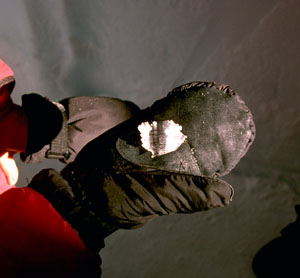
A single crystal of water ice inside an Antarctic glacier.
Paul Doherty image.
Scientists have discovered that the shape of snowflakes depends on the temperature and supersaturation of the air mass in which they form.
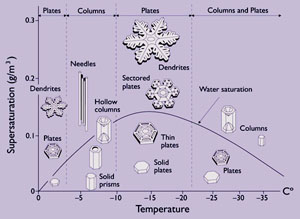
A graph showing how the shape of snowflakes depends on the
temperature and supersaturation at which they form.
Extrapolating to cold, low water vapor densities found on Mars we expect to find water ice snowflakes shaped like hexagonal plates and prisms. These shapes will produce halos around the sun with a radius of 22.5 degrees. See the image below.
Martian Carbon Dioxide Ice Crystal Shapes
Clarence Bennett and I built a chamber at Oakland University in Rochester Michigan where we could grow carbon dioxide ice crystals under Martian conditions. We attached a vacuum pump to reduce the pressure of the pure CO2 gas in the chamber to less than 6 millibars. We also added plumbing to carry liquid nitrogen into the chamber to cool it to mars temperatures. Under Mars atmospheric pressure, carbon dioxide ice forms at 140 K, or -130 °C.

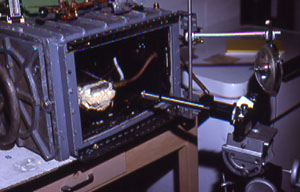
Two views of the Mars chamber in operation. Click to enlarge.
Making a Mars chamber was easy in comparison with making it snow inside the chamber. After months of work we finally produced a carbon dioxide ice snowstorm in the Mars chamber and managed to photograph the resulting snow crystals.
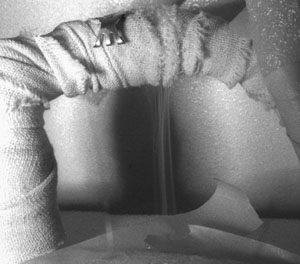
Thin tendrils of snow fall near the right side of the central
shadow band in the mars chamber. Click to enlarge.
Close up photographs of the crystals showed that they had square faces and triangular faces.
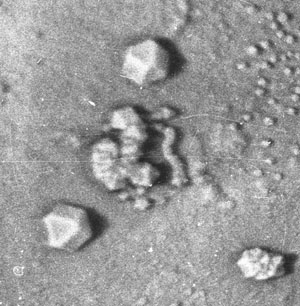
Carbon dioxide ice crystals formed under Martian conditions,
they are cuboctahedrons and twinned crystals. Click to enlarge.
We knew that carbon dioxide ice can crystallize with cubic symmetry, this meant that it could form cubes, octahedrons, or cuboctahedrons, i.e. cubes with the corners cut off. We had discovered that under Martian conditions carbon dioxide ice formed cuboctahedrons.
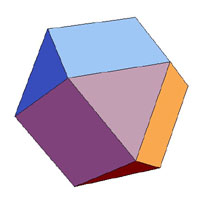
Cuboctahedron illustration by Ron Hipschman. Click to
Enlarge.
Demo. Show a model cuboctahedron made from plastic.
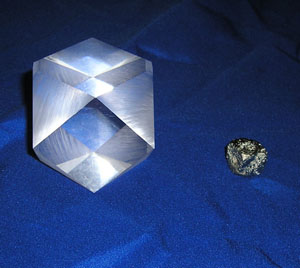
I bought a plastic cube 2" (5 cm) on a side and cut off the
corners making a plastic model of a Martian Snowflake.
I also found an iron pyrite crystal that had formed as a
cuboctahedron.
Iron pyrite also makes crystals with cubic symmetry. While Iron Pyrite, or fools gold, often makes cubes, sometimes it crystallizes as cuboctahedrons. Show an iron pyrite cuboctahedron.
Demo. Make dry ice snow with a fire extinguisher or a tank of CO2 gas.
Demo. Show dry ice.
Ice crystal Halos
Ice crystals make halos on earth. On earth the main halo is at 22 degrees radius around the sun or moon, on mars it will be at the same angle for water ice crystals.
I calculated the angle of the ice crystal halos on Mars made by carbon dioxide ice cuboctahedrons and found that they would form at 28 degrees from the sun. If you stretch out your arm to its full length in front of you then spread out your fingers and thumb the angle between the tip of your thumb and the tip of your little finger will be about 20 degrees, just about the angle between the sun and the halo on earth. The mars halo will be about 25% larger in radius than this handspan.
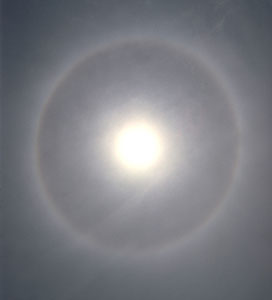
A halo around the sun on earth. Click to enlarge.
Steve Wall of JPL searched the Viking lander images for traces of Martian ice crystal halos to see if my prediction was correct, he found no halos. Later, Pathfinder looked for ice crystal halos without finding any. So now I wait for the results from the Spirit Rover. Will it see ice crystal halos? Will they be at 22.5 degrees or at 28 degrees? or at some other angle? I'm waiting.
Demo.
Stars, Planets and Moons viewed from Mars
You would be able to see the earth from the surface of Mars on a clear night, the moon too. When Pathfinder attempted to make an image of the earth from the surface of Mars, clouds got in the way. However, orbiting spacecraft have been able to image the earth and the moon from Mars. Recently the Mars Rovers have taken the first image of the earth from the surface of another planet.

The Earth and Moon photographed from Mars orbit. Image NASA/JPL/Malin
Space Science Systems
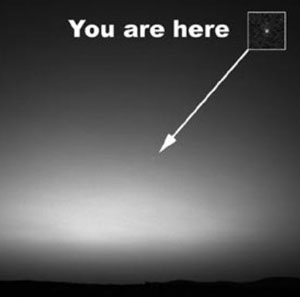
Earth from the surface of Mars.
Freezing by Boiling, water on Mars will boil at 0°C until it freezes. This exhibit uses a vacuum chamber to reproduce Mars surface conditions.
|
Scientific Explorations with Paul Doherty |
|
23 March 2004 |